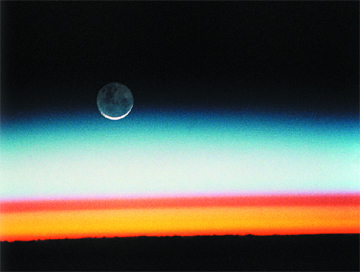 Climate
models and basic atmospheric physics hold that temperatures at Earth’s
surface and those in the lowest part of the atmosphere called the troposphere
should change in lockstep. Over the past 15 years, however, climate researchers
have observed a discrepancy: While temperatures at the surface have been quickly
on the rise, the troposphere has been warming more slowly than expected. This
difference has proved to be both a scientific and a public policy hurdle, as
global warming skeptics cite the discrepancy as proof of large uncertainties
in climate models. A new analysis of satellite data, however, has narrowed the
gap between surface and tropospheric temperatures.
Climate
models and basic atmospheric physics hold that temperatures at Earth’s
surface and those in the lowest part of the atmosphere called the troposphere
should change in lockstep. Over the past 15 years, however, climate researchers
have observed a discrepancy: While temperatures at the surface have been quickly
on the rise, the troposphere has been warming more slowly than expected. This
difference has proved to be both a scientific and a public policy hurdle, as
global warming skeptics cite the discrepancy as proof of large uncertainties
in climate models. A new analysis of satellite data, however, has narrowed the
gap between surface and tropospheric temperatures. Taken early in the morning, this sunrise shot shows the sun below the horizon, not yet illuminating the dark band of low-level clouds on the Earth “limb.” Ranging from 8 to 11 miles above these low-level clouds is a brown layer at the tropopause, the division between the troposphere and stratosphere. Scientists are trying to obtain an accurate satellite temperature record of these atmospheric layers. Courtesy of NASA.
Satellites record radiation emanating from a broad layer that extends from the bottom of the troposphere — the atmospheric layer up to 8 miles above Earth’s surface — through the lower part of the stratosphere. Cooling of the stratosphere during the past few decades has reduced the radiation reaching satellites, but calculating that cooling effect on the measurements has proven difficult. In a federally funded study published in the May 6 Nature, atmospheric researcher Qiang Fu and colleagues at the University of Washington say they have found a better way to remove the stratospheric signal from the tropospheric temperature trend.
The team used data from microwave-sounding units aboard polar-orbiting NOAA satellites that record different channels of data for different levels of the atmosphere. By subtracting the stratospheric signal from the signal of the tropospheric channel, they say, they were better able to correct for the stratospheric cooling.
“The strong cooling that has taken place in the stratosphere over the past 25 years is reflected in the data from both sensors,” says John M. Wallace, an atmospheric scientist at the University of Washington, who chaired the 1999 National Research Council Panel on reconciling observations of global temperature trends. “Removing the spurious cooling renders the tropospheric temperature trend more positive.”
After correcting satellite data recorded from January 1979 to December 2001, Fu’s team found that the warming trend in the troposphere closely matched the surface trend, as well as that predicted by climate models — about 0.17 degrees Celsius (0.306 degrees Fahrenheit) per decade.
The earlier method for correcting for the upper atmosphere cooling effect used the tropospheric channel to physically reconstruct the temperature gradient in the atmosphere from different angles above Earth. “This idea is elegant in principle,” Wallace says, “but it may be difficult to apply in practice because it’s quite sensitive and it may be subject to contamination from radiation emitted from the Earth’s surface.”
Others say the physical approach only allowed researchers to work with the part of the stratosphere that was being directly measured, which left part of the stratospheric signal unremoved. “If you simply do a physical reconstruction, which is what has been done before, that kind of a strategy only allows you to play off the region where (the stratospheric channel) is making measurements with exactly that region,” says Kevin E. Trenberth, an atmospheric scientist and head of the Climate Analysis Section at the National Center for Atmospheric Research. In contrast, the new method takes a statistical approach rather than a physical one — using data measured in one part of the stratosphere to obtain information about another statistically related, yet unmeasured, part of the stratosphere. Thus, it can “take advantage of that statistical relationship and remove the stratosphere much more completely and cleanly than we’ve been able to do before,” Trenberth says.
While controversy continues over which of the two methods yields a more accurate estimate of the trends, Wallace says that tests can be devised to determine which method is more reliable. “I think we’ll know the answer by the end of the year,” he adds.
Meanwhile, the global warming debate still rages worldwide, and resolving the tropospheric signal could play an influential role in settling it. “I think the failure to find the warming in the temperatures aloft, even though we find so much evidence of it down here at the surface, has confused the debate somewhat,” Wallace says. “If this confusion is dispelled, the case for taking actions to limit the extent of global warming will be even more compelling.”

